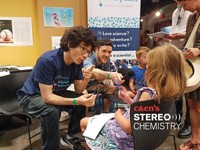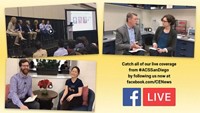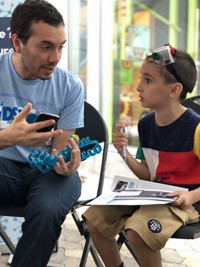Advertisement
Grab your lab coat. Let's get started
Welcome!
Welcome!
Create an account below to get 6 C&EN articles per month, receive newsletters and more - all free.
It seems this is your first time logging in online. Please enter the following information to continue.
As an ACS member you automatically get access to this site. All we need is few more details to create your reading experience.
Not you? Sign in with a different account.
Not you? Sign in with a different account.
ERROR 1
ERROR 1
ERROR 2
ERROR 2
ERROR 2
ERROR 2
ERROR 2
Password and Confirm password must match.
If you have an ACS member number, please enter it here so we can link this account to your membership. (optional)
ERROR 2
ACS values your privacy. By submitting your information, you are gaining access to C&EN and subscribing to our weekly newsletter. We use the information you provide to make your reading experience better, and we will never sell your data to third party members.
Programs
Kids interview scientists at Science Storytellers event in Boston
by Jessica Marshall
September 22, 2018
| A version of this story appeared in
Volume 96, Issue 38

It’s a simple idea. Introduce a kid to a scientist, and let the child ask questions—whatever they wonder about. Then ask the child to reflect a little on the conversation when it’s over by drawing a picture or writing a few words. This is the gist of Science Storytellers, a program founded by freelance science writer Jennifer Cutraro. At the ACS national meeting in Boston last month, C&EN partnered with Science Storytellers to bring this program to the ACS Kids Zone event held at the Boston Children’s Museum.
Cutraro, who has experience in both science journalism and science education, started the program a little more than a year ago. “I started to think about what it could look like if we got kids and scientists talking to each other very informally,” she says. There are no whiz-bang demonstrations or long-winded lectures. It’s just a chat.
“I have been blown away by the level of enthusiasm that both scientists and kids show for talking to each other in this manner,” Cutraro says “I’ve heard from multiple scientists that they have never had the opportunity to do this type of small-scale, unscripted engagement with the public.”
By interviewing scientists, the kids played the role of science journalists. They received a reporter’s notebook, a pen, and a sticky note printed with conversation-starting questions they could ask a scientist. C&EN staff at the booth helped introduce the kids to the scientists, explaining a journalist’s role in bringing scientists’ work to the public.
Partnering with a program that exposes kids not only to chemistry but also to journalism appealed to C&EN, says Lauren K. Wolf, C&EN’s deputy editorial director, who participated in the event. “The program has the added advantage of demonstrating for kids that scientists are regular people,” she says.
The scientist volunteers who answered the kids’ questions spanned the fields of materials science, medicinal chemistry, microbiology, and more. Many came from universities and companies in the Boston area, and some, such as Pedro García Barrantes and Emily P. Balskus, are past or current members of C&EN’s Talented 12.
“The kids were very inquisitive,” says García Barrantes, a scientist at Vertex Pharmaceuticals. “I was surprised about the level of their questions and at how they have created their own theories to explain what they see in the world.”
Harvard University’s Balskus adds, “This is a terrific organization and also a very timely effort. Not only is it becoming increasingly important that scientists better communicate the importance of their work to the general public, but it is also becoming critical that we find ways to share what good journalism entails. This allows kids to see the personal side of science while also learning that they can ask questions and be curious about the world around them—just like scientists are.”
The author of this story helped organize and participated in the Science Storytellers event in Boston.





Join the conversation
Contact the reporter
Submit a Letter to the Editor for publication
Engage with us on Twitter